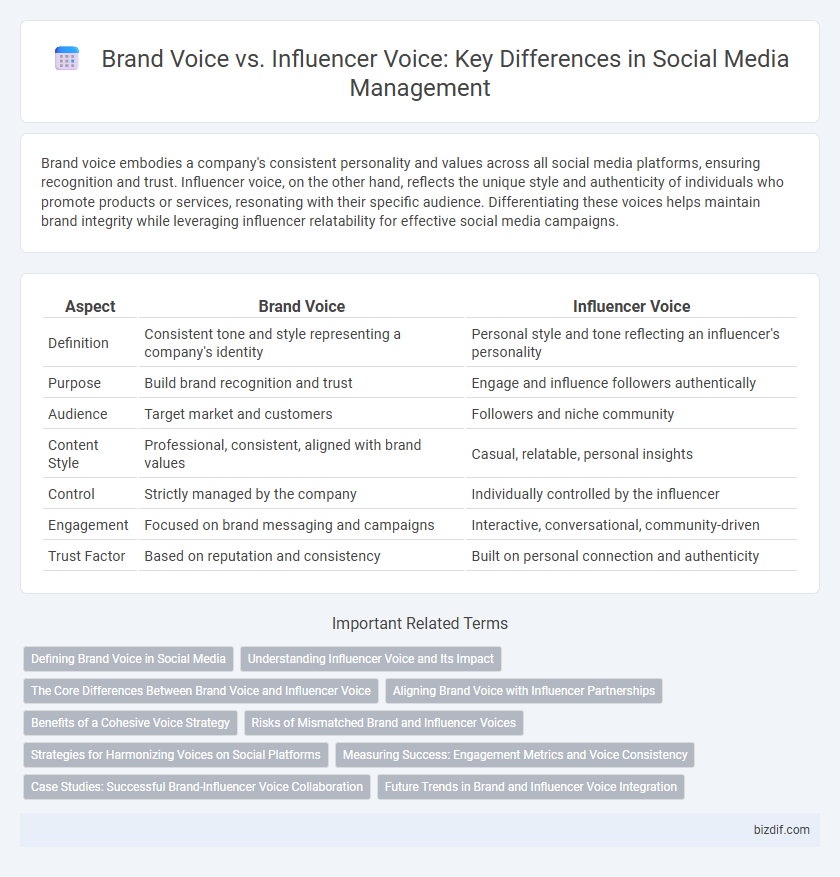Brand voice embodies a company's consistent personality and values across all social media platforms, ensuring recognition and trust. Influencer voice, on the other hand, reflects the unique style and authenticity of individuals who promote products or services, resonating with their specific audience. Differentiating these voices helps maintain brand integrity while leveraging influencer relatability for effective social media campaigns.
Table of Comparison
| Aspect | Brand Voice | Influencer Voice |
|---|---|---|
| Definition | Consistent tone and style representing a company's identity | Personal style and tone reflecting an influencer's personality |
| Purpose | Build brand recognition and trust | Engage and influence followers authentically |
| Audience | Target market and customers | Followers and niche community |
| Content Style | Professional, consistent, aligned with brand values | Casual, relatable, personal insights |
| Control | Strictly managed by the company | Individually controlled by the influencer |
| Engagement | Focused on brand messaging and campaigns | Interactive, conversational, community-driven |
| Trust Factor | Based on reputation and consistency | Built on personal connection and authenticity |
Defining Brand Voice in Social Media
Defining brand voice in social media involves creating a consistent tone, language, and personality that reflects the company's core values and resonates with its target audience. Unlike influencer voice, which is often personal, spontaneous, and varied, brand voice maintains uniformity across all platforms to build trust and recognition. Key elements include clarity, authenticity, and alignment with brand identity to enhance engagement and reinforce brand positioning.
Understanding Influencer Voice and Its Impact
Influencer voice reflects a unique personal style and authentic tone that resonates with their audience, distinguishing it from the consistent and strategic brand voice. Understanding influencer voice is crucial for social media management as it shapes audience perception, engagement, and trust in collaborations. Effective alignment between brand voice and influencer voice maximizes campaign impact by ensuring authenticity and relevance in messaging.
The Core Differences Between Brand Voice and Influencer Voice
Brand voice represents a company's consistent tone, style, and messaging across all social media platforms, reflecting its values and identity. Influencer voice is more personal, authentic, and opinion-driven, shaped by individual experiences and audience engagement. The core difference lies in brand voice aiming for uniformity and strategic communication, while influencer voice prioritizes relatability and trust through personal storytelling.
Aligning Brand Voice with Influencer Partnerships
Aligning brand voice with influencer partnerships ensures consistent messaging across social media platforms, enhancing audience trust and engagement. Brands must collaborate with influencers whose tone, values, and style complement their established identity to maintain authenticity. Effective alignment drives stronger brand recognition and maximizes the impact of influencer campaigns.
Benefits of a Cohesive Voice Strategy
A cohesive voice strategy in social media management ensures consistent brand messaging that builds trust and recognition across platforms. Aligning brand voice with influencer voice amplifies authenticity and strengthens audience connection, driving higher engagement rates. This synergy enhances brand loyalty and maximizes the impact of marketing campaigns through unified communication.
Risks of Mismatched Brand and Influencer Voices
Mismatched brand and influencer voices can confuse audiences and weaken brand identity, resulting in reduced trust and engagement. Inconsistent messaging may alienate loyal customers while failing to attract new followers, ultimately harming social media performance. Aligning brand and influencer voices ensures cohesive storytelling that resonates with target demographics and maximizes campaign effectiveness.
Strategies for Harmonizing Voices on Social Platforms
Aligning brand voice with influencer voice requires developing clear guidelines that reflect brand values and tone while allowing influencers to authentically connect with their audience. Leveraging consistent messaging frameworks and collaborative content planning ensures cohesiveness across social platforms, enhancing brand recognition and trust. Monitoring engagement metrics and audience feedback helps refine strategies to maintain a harmonious and impactful online presence.
Measuring Success: Engagement Metrics and Voice Consistency
Measuring success in social media management requires differentiating between brand voice and influencer voice by analyzing engagement metrics such as likes, comments, shares, and follower growth to determine audience resonance. Brand voice consistency strengthens recognition and trust, tracked through sentiment analysis and message alignment across posts. Influencer voice success hinges on authentic engagement and conversion rates, monitored through unique promo codes and click-through rates that reflect genuine audience connection.
Case Studies: Successful Brand-Influencer Voice Collaboration
Case studies reveal that successful brand-influencer voice collaboration hinges on aligning core values and audience tone, enhancing engagement and authenticity. Brands like Nike partnering with athletes such as Serena Williams demonstrate how consistent messaging amplifies campaign impact and consumer trust. Data from these collaborations show increased social media reach and conversion rates when brand and influencer voices complement each other seamlessly.
Future Trends in Brand and Influencer Voice Integration
Emerging trends in social media management emphasize the seamless integration of brand voice and influencer voice to enhance authenticity and engagement. Advanced AI tools enable real-time analysis and alignment of tone, ensuring consistent messaging across platforms while allowing influencers to maintain personal appeal. This convergence drives deeper audience connection and fosters trust, positioning brands for greater long-term loyalty.
Brand voice vs Influencer voice Infographic

 bizdif.com
bizdif.com